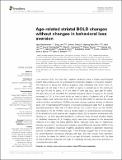| dc.contributor.author | Viswanathan, Vijay | en_US |
| dc.contributor.author | Lee, Sang | en_US |
| dc.contributor.author | Gilman, Jodi M. | en_US |
| dc.contributor.author | Kim, Byoung Woo | en_US |
| dc.contributor.author | Lee, Nick | en_US |
| dc.contributor.author | Chamberlain, Laura | en_US |
| dc.contributor.author | Livengood, Sherri L. | en_US |
| dc.contributor.author | Raman, Kalyan | en_US |
| dc.contributor.author | Lee, Myung Joo | en_US |
| dc.contributor.author | Kuster, Jake | en_US |
| dc.contributor.author | Stern, Daniel B. | en_US |
| dc.contributor.author | Calder, Bobby | en_US |
| dc.contributor.author | Mulhern, Frank J. | en_US |
| dc.contributor.author | Blood, Anne J. | en_US |
| dc.contributor.author | Breiter, Hans C. | en_US |
| dc.date.accessioned | 2015-06-02T12:22:01Z | |
| dc.date.issued | 2015 | en_US |
| dc.identifier.citation | Viswanathan, V., S. Lee, J. M. Gilman, B. W. Kim, N. Lee, L. Chamberlain, S. L. Livengood, et al. 2015. “Age-related striatal BOLD changes without changes in behavioral loss aversion.” Frontiers in Human Neuroscience 9 (1): 176. doi:10.3389/fnhum.2015.00176. http://dx.doi.org/10.3389/fnhum.2015.00176. | en |
| dc.identifier.issn | 1662-5161 | en |
| dc.identifier.uri | http://nrs.harvard.edu/urn-3:HUL.InstRepos:16120990 | |
| dc.description.abstract | Loss aversion (LA), the idea that negative valuations have a higher psychological impact than positive ones, is considered an important variable in consumer research. The literature on aging and behavior suggests older individuals may show more LA, although it is not clear if this is an effect of aging in general (as in the continuum from age 20 and 50 years), or of the state of older age (e.g., past age 65 years). We also have not yet identified the potential biological effects of aging on the neural processing of LA. In the current study we used a cohort of subjects with a 30 year range of ages, and performed whole brain functional MRI (fMRI) to examine the ventral striatum/nucleus accumbens (VS/NAc) response during a passive viewing of affective faces with model-based fMRI analysis incorporating behavioral data from a validated approach/avoidance task with the same stimuli. Our a priori focus on the VS/NAc was based on (1) the VS/NAc being a central region for reward/aversion processing; (2) its activation to both positive and negative stimuli; (3) its reported involvement with tracking LA. LA from approach/avoidance to affective faces showed excellent fidelity to published measures of LA. Imaging results were then compared to the behavioral measure of LA using the same affective faces. Although there was no relationship between age and LA, we observed increasing neural differential sensitivity (NDS) of the VS/NAc to avoidance responses (negative valuations) relative to approach responses (positive valuations) with increasing age. These findings suggest that a central region for reward/aversion processing changes with age, and may require more activation to produce the same LA behavior as in younger individuals, consistent with the idea of neural efficiency observed with high IQ individuals showing less brain activation to complete the same task. | en |
| dc.language.iso | en_US | en |
| dc.publisher | Frontiers Media S.A. | en |
| dc.relation.isversionof | doi:10.3389/fnhum.2015.00176 | en |
| dc.relation.hasversion | http://www.ncbi.nlm.nih.gov/pmc/articles/PMC4415398/pdf/ | en |
| dash.license | LAA | en_US |
| dc.subject | loss aversion | en |
| dc.subject | aging | en |
| dc.subject | nucleus accumbens | en |
| dc.subject | reward | en |
| dc.subject | fMRI | en |
| dc.subject | neurocompensation | en |
| dc.title | Age-related striatal BOLD changes without changes in behavioral loss aversion | en |
| dc.type | Journal Article | en_US |
| dc.description.version | Version of Record | en |
| dc.relation.journal | Frontiers in Human Neuroscience | en |
| dash.depositing.author | Lee, Sang | en_US |
| dc.date.available | 2015-06-02T12:22:01Z | |
| dc.identifier.doi | 10.3389/fnhum.2015.00176 | * |
| dash.authorsordered | false | |
| dash.contributor.affiliated | Breiter, Hans C. | |
| dash.contributor.affiliated | Gilman, Jodi | |
| dash.contributor.affiliated | Blood, Anne | |
| dash.contributor.affiliated | Lee, Sang | |


